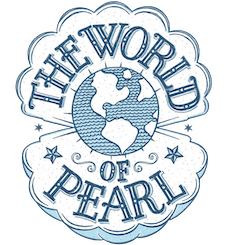 Bigger is better especially in the newest wave of freshwater pearls coming out of China. Are you interested in big freshwater pearls? Many of you have been asking about the rapidly increasing prices for smaller size cultured pearls. These smaller pearls are becoming more and more scarce because the newest wave of cultured pearls is focusing on bigger pearls. And the secret to culturing large freshwater pearls is in the foot… or behind the foot to be exact.
Bigger is better especially in the newest wave of freshwater pearls coming out of China. Are you interested in big freshwater pearls? Many of you have been asking about the rapidly increasing prices for smaller size cultured pearls. These smaller pearls are becoming more and more scarce because the newest wave of cultured pearls is focusing on bigger pearls. And the secret to culturing large freshwater pearls is in the foot… or behind the foot to be exact.
Here is the nitty gritty: To create large pearls without devoting 5 years, 10 years or more to culturing pearls, it is key to start with a nucleus. Chinese freshwater pearls are typically tissue nucleated so the classic 7mm pearls take 3-5 years to form. And alot can happen in three to five years. Imagine how long it takes to create a 10mm, 12mm or larger pearls? And imagine the risk of culturing pearls for that long! This is a risk alot of pearl farmers are scared to take.
Remember that South Sea pearls, Tahitian pearls and Akoya pearls all have a bead nucleus. Tissue nucleation is one thing that sets these Chinese freshwater pearls apart.
The Chinese pearl farmer realized that creating large pearls are important but they also recognized that freshwater mussels are not always responsive to having a nucleus. That is why the whole industry started with tissue nucleation. Now they discovered that if a nucleus is placed behind the foot, a mussel cannot remove it and it has room to create a large pearl.
So, the answer to the large pearl is in the foot. Most people think that mussels are immobile. It is true that some adult mussels may be sessile (immobile) as adults but those same mussels may have been mobile in their youth. And even some adult mussels may move when they need to. And to move, they use their foot. Basically the foot looks like a tongue and acts like an anchor that is inserted into the ground so the mussel can pull its body and shell over the ground.It is a slow go, no doubt, but the foot helps the mussel move, attach to a substrate or burrow in the soft bottom of its water habitat.
By placing a nucleus behind the foot, the mussel has room to create a larger pearl and it is less likely to reject the nucleus. Although freshwater pearls produce many pearls at a time, it can only produce one of these larger nucleated pearls at a time. So, the time it takes to create the large pearls coupled with the inability to culture many pearls at one time, increases the price of these gems. Plus there are fewer available and demand is growing for the larger Chinese freshwater pearls.
You can see what we offer in the nucleated, big freshwater pearls by viewing the Angel Wing Earrings and Angel Wing Necklace. The part of the pearl that I affectionately refer to as the “angel wing” is a growth pattern of the pearl that is, again, because of its growth behind the foot!
There is another way that Chinese pearls are getting bigger, it you are interested, read more here: Large Pearls, Large Pearl Sac
I am a modern day treasure hunter who travels the world for gorgeous pearls and amazing adventures. I own a pearl jewelry and jewelry repair business, ThePearlGirls.com, with a cute retail store in Athens, GA. I also have a Pearl Travel business and travel blog at TheWorldofPearl.com.




